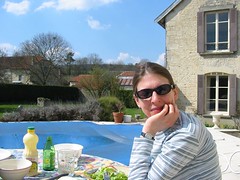Until yesterday no museum featured in my list of favourite special places. My list does include a restaurant (Greens in San Francisco) , a stretch of road (the D6 between Maranville and Cirfontaines - at the moment this lovely curve around the local contours doesn't have a website), a house (Gerbestone Manor in Somerset), a garden (East Ruston Old Vicarage gardens in Norfolk) and a bookshop (Shakespeare and Co in Paris). But up to now there’s not been a museum. Until yesterday, that is, when we went to the new Charles de Gaulle Memorial museum in Columbey-les-Deux-Eglises, just a stone’s throw from home.
Mind you, this is no ordinary museum.
We’d been watching from afar for some time as this amazing building forced its way through the hillside, as on clear days we can see the site on our usual walk with Circé. However, it’s only when you get close to it that you’re struck with just what an achievement it was to construct and complete this amazing building and the exhibition it houses in just two years.
As we took the lift from the back of the limestone-lined entrance cathedral, we felt as if we were being elevated into the heavens through a backdrop of tiny twinkling blue lights. Then, like a scene in a science fiction novel the lift doors opened onto a small landing and an ignominious black door. Were we meant to go in, or had we been lifted too high?
We opened this door not so much into another world, but a familiar one; the landscape we love so much, the rolling hills, dramatic horizons and deep forests of our corner of Haute-Marne.
‘Chapeau’ to the exhibition’s designers who took us from beauty of the Haute-Marne countryside and back again via the trenches of the first world war, the north African desert and the streets of 1968 Paris.
What’s so clever is the detail which brings the man to life; not just the usual family photographs and extracts from letters, although there are plenty of those, but things like the opened trunk full of the necessities of itinerant life – with a detailed narrative to go with it so you know why among the dress-suits and military documents there’s a boiled egg and a thermometer.
Unsurprisingly, I was enthralled by the section on communications - the importance of radio and the role the BBC played in the drama, the underground newspapers and the people who put them together, the huge challenge of rallying the hopes of the oppressed French nation around someone who was, for the most part, completely unknown. Most people didn’t even know what Charles de Gaulle looked like. This makes my old job seem like a piece of cake!
By this stage of the journey I was used to being surprised and delighted so instinctively looked up after learning how de Gaulle’s sister-in-law and niece took huge risks to tackle this problem. And what was there but a 1940’s Parisian living room complete with sideboard and dining table suspended upside down above my head!
And through all this the landscape on the other side of the giant’s letter-box windows of this fantastic building is woven into the fabric of the story, whether it be a glimpse through a gate behind a pile of postbags or through the windows of a reconstruction of de Gaulle’s study.
And this was the best for me – how much the beauty and drama of the countryside I now call home was the central theme of the story. We were told at the beginning of that de Gaulle picked Haute-Marne as his home because its grandeur and austerity matched his personality. In a strange way, and I make no apologies for how this sounds, it gave me a kind of connection with him, knowing there’s something so fundamental we share – a deep love and admiration for this little-known corner of France.
It was so wet and horrible yesterday that we didn't bother to take the camera - thinking that we wouldn't be able to take pictures inside. However, photography is allowed and there's a brilliant Flickr set here. Joseph Melin has captured the essence of the place far better than I could ever hope to.

